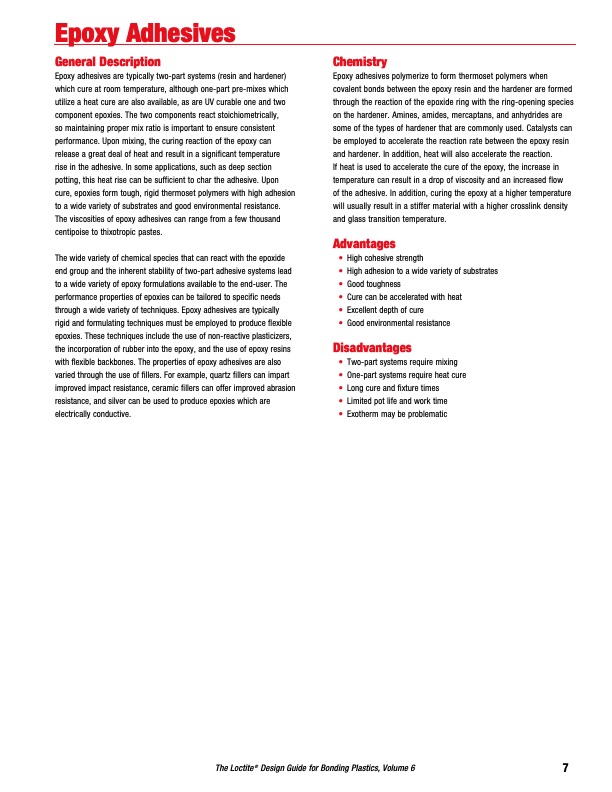
PDF Publication Title:
Text from PDF Page: 009
Epoxy Adhesives General Description Epoxy adhesives are typically two-part systems (resin and hardener) which cure at room temperature, although one-part pre-mixes which utilize a heat cure are also available, as are UV curable one and two component epoxies. The two components react stoichiometrically, so maintaining proper mix ratio is important to ensure consistent performance. Upon mixing, the curing reaction of the epoxy can release a great deal of heat and result in a significant temperature rise in the adhesive. In some applications, such as deep section potting, this heat rise can be sufficient to char the adhesive. Upon cure, epoxies form tough, rigid thermoset polymers with high adhesion to a wide variety of substrates and good environmental resistance. The viscosities of epoxy adhesives can range from a few thousand centipoise to thixotropic pastes. The wide variety of chemical species that can react with the epoxide end group and the inherent stability of two-part adhesive systems lead to a wide variety of epoxy formulations available to the end-user. The performance properties of epoxies can be tailored to specific needs through a wide variety of techniques. Epoxy adhesives are typically rigid and formulating techniques must be employed to produce flexible epoxies. These techniques include the use of non-reactive plasticizers, the incorporation of rubber into the epoxy, and the use of epoxy resins with flexible backbones. The properties of epoxy adhesives are also varied through the use of fillers. For example, quartz fillers can impart improved impact resistance, ceramic fillers can offer improved abrasion resistance, and silver can be used to produce epoxies which are electrically conductive. Chemistry Epoxy adhesives polymerize to form thermoset polymers when covalent bonds between the epoxy resin and the hardener are formed through the reaction of the epoxide ring with the ring-opening species on the hardener. Amines, amides, mercaptans, and anhydrides are some of the types of hardener that are commonly used. Catalysts can be employed to accelerate the reaction rate between the epoxy resin and hardener. In addition, heat will also accelerate the reaction. If heat is used to accelerate the cure of the epoxy, the increase in temperature can result in a drop of viscosity and an increased flow of the adhesive. In addition, curing the epoxy at a higher temperature will usually result in a stiffer material with a higher crosslink density and glass transition temperature. Advantages • High cohesive strength • High adhesion to a wide variety of substrates • Good toughness • Cure can be accelerated with heat • Excellent depth of cure • Good environmental resistance Disadvantages • Two-part systems require mixing • One-part systems require heat cure • Long cure and fixture times • Limited pot life and work time • Exotherm may be problematic The Loctite® Design Guide for Bonding Plastics, Volume 6 7PDF Image | Design Guide for Bonding Plastics Volume 6 LT-2197

PDF Search Title:
Design Guide for Bonding Plastics Volume 6 LT-2197Original File Name Searched:
henkel-loctite-design-guide-plastic-bonding.pdfDIY PDF Search: Google It | Yahoo | Bing
Development of a solar powered Electric Ship The Electricship website originally started off as a project to develop a comprehensive renewable, affordable, modular electric ship... More Info
Modular Boat Hull Composite The case for a unsinkable, modular composite hybrid boat hull... More Info
MS Burgenstock Hybrid Electric Catamaran Lake Lucerne Unique shuttle servicing Lucerne to the Burgenstock Resort... More Info
Ground Power Unit GPU Powered by Lithium Ion Batteries The goal of the Ground Power Unit is to provide a readily accessible, modular, ready-to-power solution for remote power... More Info
| CONTACT TEL: 608-238-6001 Email: greg@electricship.com | RSS | AMP |